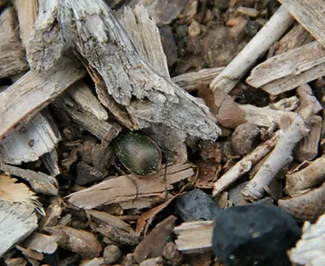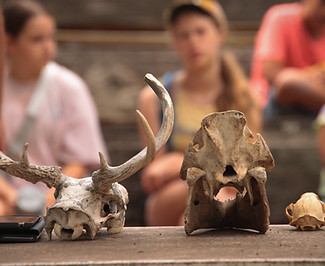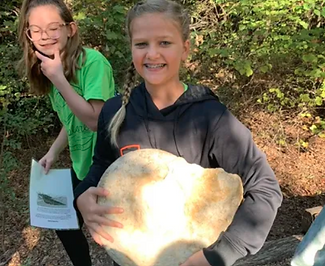

Entomology
What is an insect? A spider? What are their adaptations? Why do insects undergo metamorphosis anyways? Those are just some of the questions that we explore in this class. Whether it be with our insect display cases or specimens found in the forest, students get an up-close and personal experience with these exciting creatures. After identifying and discussing insect body parts (exoskeleton, antennas, wings etc.) students move to catch insects out in the forest; we look under logs, rocks, in the leaves, and up in the trees!
Download the Entomology journal page >>

Animal Tracking
Animal Tracking is the method and way of tracking an animal used most by hunters and scientists. And as novice scientists, students are allowed to discuss what clues and stories are left behind by the animals that inhabit Camp Jolt. After exploring the difference between sign and print tracking, answering what a niche is, and what sorts of organisms are most commonly found here, students are encouraged to search for their own animal track and scientifically record their findings!
Download Animal Tracking journal page >>

Fossil Hunt
After a hike to one of our many natural fossil beds on camp, students are led in a discussion about fossils. Focusing on life from the Cretaceous Era, we go over how fossils are made, and the different types. Then the students are handed field guides and are given the opportunity to hunt for fossils! Their journal page has a place for them to record data from the fossils that they find, such as sketches, measurements, types, and the identification of several fossils. (This class pairs well with the Hike to the Monkey Bridge, as there is a great fossil site out there.)

Herpetology
How are reptiles and amphibians different? How are they the same? These are some of the questions that we explore in this class. We focus on concepts such as adaptations generally and how they apply to Herps. Other concepts include; their roles in the food web, ecto and endothermic (“Cold” and “Warm” blooded) and a comparison to mammals. After instruction on proper methods of collection (students are to leave all snakes for an instructor to assess), students head out to find their own specimen. We provide an ID guide, a long stick to move rocks and logs at a distance, and collection containers. In the spring and fall, we find frogs, toads, lizards, and earth snakes. The best time for this class is in the nonwinter months. However, we do have two captive reptiles, a ball python and a bearded dragon, that we can show students should your group decide to learn about Herps in the winter.

The Ins and Outs of Trees
Students draw the parts of a tree and discuss their importance. They are given tree sections to discover the tree’s age and learn about it’s past. After covering concepts such as photosynthesis and autotroph, we ask students to consider renewable resources. Are trees renewable? What about forest ecosystems? Students list as many examples of renewable resources as they can think of. After learning about the characteristics of conifer and deciduous trees students are given six different trees to identify and learn about.

Orienteering
Students learn the basics of map reading using a compass while completing various courses, designed exclusively for All Saints by the president of the North Texas Orienteering Association (NTOA). Beginner to advanced sessions available.
.png)
Owl Pellet Dissection*
Owls are an important part of the Cross Timbers food web. Students learn about owls, their adaptations and role in the food web. Included in this course is a discussion of nocturnal vs. diurnal animals, raptors and food web concepts such as producer and consumers. A key feature to this class is the owl pellet dissection, where students are allowed to discover first hand what owls eat and how. Usually in groups of 2 or 3 students break down the pellets and try to identify the prey using bones, fur and feathers as clues. This doubles as a great introduction to anatomy as students learn about mandibles, ribs, femurs and rodent or bird skulls. This class pairs very well with the Blackland Prairie Raptors presentation. Key concepts includes; Raptors, food web, primary producers, etc.
* This course has an extra fee associated with it.

ORT
Our ORT program allows our instructors to speak to our efforts to reduce food waste. This initiative allows us to not only reduce food waste, but will allow the students to be more conscious of their eating habits as well.
.png)
Raptor Presentation*
The Backland Raptor Center Presentation lets kids get up close with some of the local birds of prey. The presenters are very knowledgeable and have an enthusiasm that makes kids want to learn.
* This course has an extra fee associated with it.

Soils Investigation
During Soils students learn about organic and inorganic matter, the rock cycle and decomposers. Emphasis is placed on soil creation through weathering and decomposition. Students learn about worms through our worm bin or explore the woods in search of their own decomposers. Throughout their hikes instructors point out examples of weathering, erosion and deposition while bring those concepts back to soil and its origins.

Wonders of Wetlands
What is a wetland? Why are wetlands important? These are just some of the questions that we explore in our Waders class. Students learn about wetland ecology, aquatic macroinvertebrates, and biological pollution indicators.
After a short discussion and explanation, students enter the lake using waders or rubber boots. Using nets and their hands students find and collect as many wetland specimens as they can! After, during our identification time,
we discuss our findings and what that tells us about pollution levels in Lake Texoma.

Weather Watch
What is the weather? How are clouds made? What causes tornadoes? These are just a few of the questions that we try to answer in this class. We also play a game that goes in-depth into the water cycle, where the students take a short trip as drops of water. Then students are taught about cloud formation and the different types. Later we head outside to use several tools and guides to measure the current temperature, barometric pressure, humidity, rainfall, wind speed, and identify the cloud cover and types.

JOLT Hike
This guided hike at Camp JOLT combines highlights from several classes—fossils, soils, trees, and more—into one hands-on adventure. Campers explore native plant life, investigate soil layers, and discover fossil evidence, all while learning about the history of Lake Texoma. It’s a fun, engaging way to connect with nature and experience the full spirit of JOLT learning in a single outdoor journey.
NEW CLASS!!!!!

Nestled on the shores of Texoma, Texas Elks Camp offers a serene escape into nature. Surrounded by lush forests and stunning lake views, our campsite provides the perfect setting for outdoor enthusiasts. Whether you're seeking adventure or relaxation, our campsite has something for everyone. From hiking trails to fishing spots, each corner of our camp invites you to explore the beauty of the great outdoors. Join us at Texas Elks Camp and create unforgettable memories in the heart of nature.
